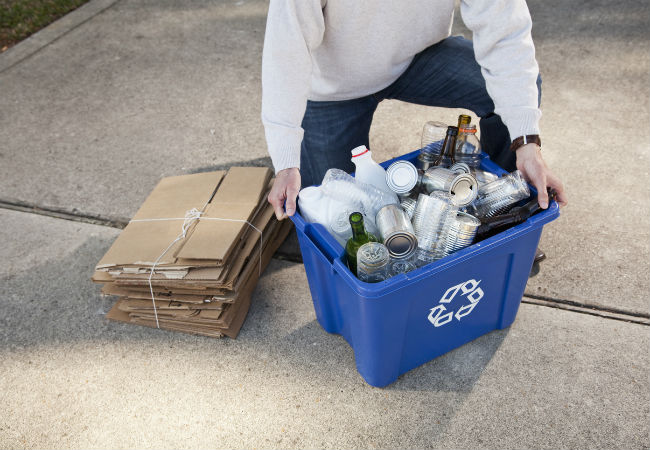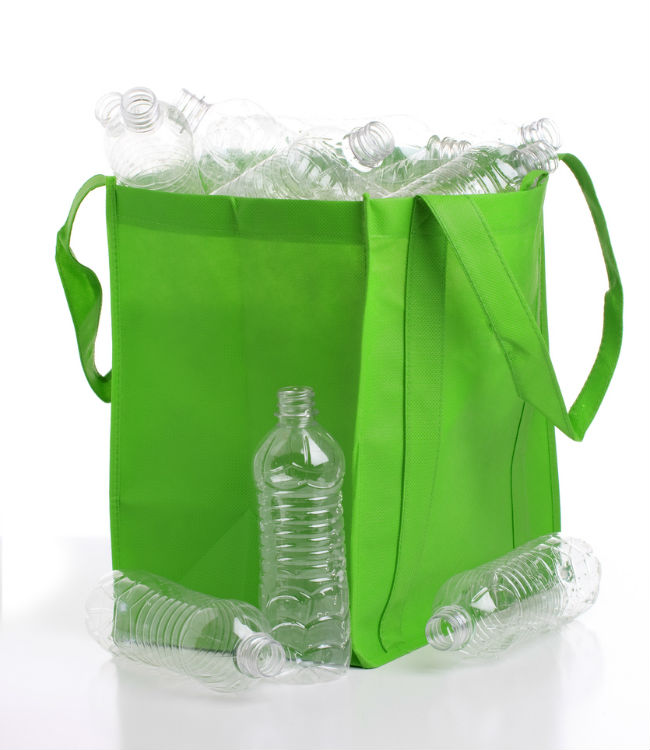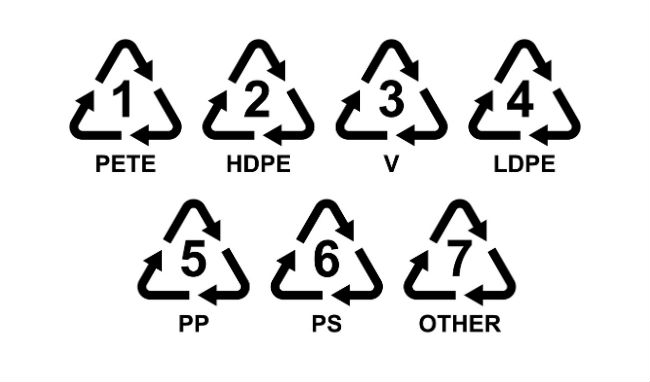

We may earn revenue from the products available on this page and participate in affiliate programs. Learn More ›
Want to recycle more, but don’t know what—and what not—to toss in the green bin? Recycling symbols have been imprinted on the products or packages of popular consumer goods since the early ‘70s to give eco-conscious folks a better idea of what goes into the recycling bin and what should be relegated to the trash. But given the mysterious mix of arrows and numbers that make up these symbols, it’s no surprise that Americans inadvertently trash enough recyclable material to fill up an entire football stadium every day, according to the Recycling Coalition of Utah.
To clear up the confusion, we’ve prepared this guide to these must-know recycling symbols:
- universal recyclables,
- recycled goods,
- and plastics.
RELATED: I Started Recycling in 2023—Here’s Why It’s Not What I Expected
UNIVERSAL RECYCLABLES
Look for one of these two symbols on a product or package to confirm that it has the potential to be recycled: ♲, ♻
Known as the Mobius loop, or the universal recycling symbol, the triangular formation of three white arrows pointing clockwise (or the more modern, solid black variant) represents the three stages of the waste hierarchy: reduce, reuse, and recycle. A product or product package that sports this symbol is recyclable (i.e., made of materials suitable for recycling, like paper, metal, plastic, or glass) but can only be recycled if:
- Your local government offers a recycling program (either curbside recycling at your home or at a collection center).
- The container material and type is accepted by your local recycling program. For example, your city might accept paper, but not soiled cardboard pizza boxes, or it might take plastics, but not all plastic types.
- The container has been readied for recycling (e.g., emptied and cleaned) as specified in local recycling ordinances.

RECYCLED
To be even more planet-friendly, you may wish to know if the products and/or packaging you buy are made with recycled material. To find out, look for text below the symbol that states the percentage of recycled content it contains (e.g., “45 percent recycled content”). Also look for the symbols described directly below. The presence of one of these three symbols on a product or product package tells you that it was made with recycled material that would otherwise have entered the waste stream. But, as you’ll read, “recycled” doesn’t necessarily mean “recyclable.”
1. Fully recycled: ♼
A product or package that displays a white Mobius loop inside a black circle was manufactured with 100 percent recycled materials, i.e., materials that were used in one product and are being reused in another product. Some, but not all, products or packages in this category are also recyclable. For example, printer paper made of 100 percent recycled paper is generally also recyclable. But napkins made of 100 percent recycled plastic are not recyclable once used. So you should also look for the universal recycling symbol or the text “This product can be recycled” or “Recyclable” on the product and consult your own local recycling ordinances to determine whether or not you can actually recycle it.
2. Partially recycled: ♽
A black Mobius loop inside a white circle indicates that a product or package was made with both recycled and non-recycled (i.e., new) materials. Unless the product or package also contains the universal recycling symbol or text that indicates it is recyclable, you should assume that it is not recyclable as the new material combined with the recycled material might not be recyclable.
3. Percentage recycled
The third variant of the white Mobius loop looks an awful lot like the “fully recycled” symbol (white Mobius loop inside a black circle) except that displays a number at its center. This symbol indicates a product or package was made with some partially recycled material, and the number on it represents the percentage of recycled content that the product contains. Even if the percentage of recycled content is high, you should still look for an accompanying universal recycling symbol or text that indicates that the product or package is recyclable before you recycle it.

DECODING SYMBOLS ON PLASTICS
Although plastic as often recyclable, the sheer variety of plastics makes it tricky to tell which types are recyclable. For this reason, the Society of Plastics Industry introduced a resin coding system in 1988, so that each product or package made of plastic features a number inside of three chasing arrows that corresponds to the category of plastics to which the product belongs.
The symbol may or may not also feature an abbreviation below the arrows of the specific resin of which plastics in that category are made. The seven types of plastic, their makeup, and their potential for recycling are as follows:

Type 1: ♳
This thin plastic made of the resin polyethylene terephthalate (abbreviated as “PETE” or “PET”) is one of the most widely used plastics. It features in disposable products both edible and non-edible, including water, soda, oil, and salad dressing bottles; peanut butter jars; and mouthwash and laundry detergent containers. Most recycling programs accept this ubiquitous plastic as it easily breaks down and doesn’t leach much of its chemicals.

Type 2: ♴
This thicker plastic is made of high-density polyethylene (HDPE), a resin that commonly features in the packages of products that have a limited shelf life or hold waste or chemicals, such as milk and yogurt containers, juice bottles, margarine tubs, household cleaner bottles, and trash bags. Plastic bags made of HDPE display “PE-HD” in their recycling code instead of HDPE. Most municipalities allow for recycling Type-2 plastic; it also breaks down easily with minimal chemical leaching.

Type 3: ♵
Made of Polyvinyl Chloride (PVC) or Vinyl (V), these versatile plastics feature in both rigid products such as cleaner bottles, pipes, and carpet backing and flexible goods like wire and cable casing and shower curtains. Most recycling programs don’t accept Type-3 plastics because they emit toxic gases when incinerated.

Type 4: ♶
Tough yet flexible, Type-4 plastic made of Low-Density Polyethylene (LDPE) is featured in frozen food packaging, tote bags, squeezable bottles, and cable jacketing. Type-4 plastic bags usually display the abbreviation “PE-LD” rather than LDPE in their recycling code, but this refers to the same plastic. Most recycling programs don’t yet accept Type-4 plastic because of its current low potential for reuse.

Type 5: ♷
This type of plastic is made of Polypropylene (PP), a highly heat- and chemical-resistant resin used in diapers, bottle caps, packing tape, ice scrapers, brooms, and rakes. More and more local recycling programs are beginning to take Type-5 plastic.

Type 6: ♸
Polystyrene (PS) plastic can be clear and hard as found in CD cases or foamed to make Styrofoam, a go-to material for to-go boxes, packing peanuts, egg cartons, and disposable drink cups. PS plastic is rarely accepted by recycling programs because it decomposes at an extremely slow rate and leaches a substantial amount of chemicals when broken down.

Type 7: ♹
A catch-all for plastics made of resins outside of the previous six types, this category includes packages and containers made of BPA or Polycarbonate, such as found in food storage containers, reusable water bottles, and plastic lumber. Don’t put this plastic out with your recyclables; most recycling programs do not accept it because of the toxic chemicals it leaches when broken down.
